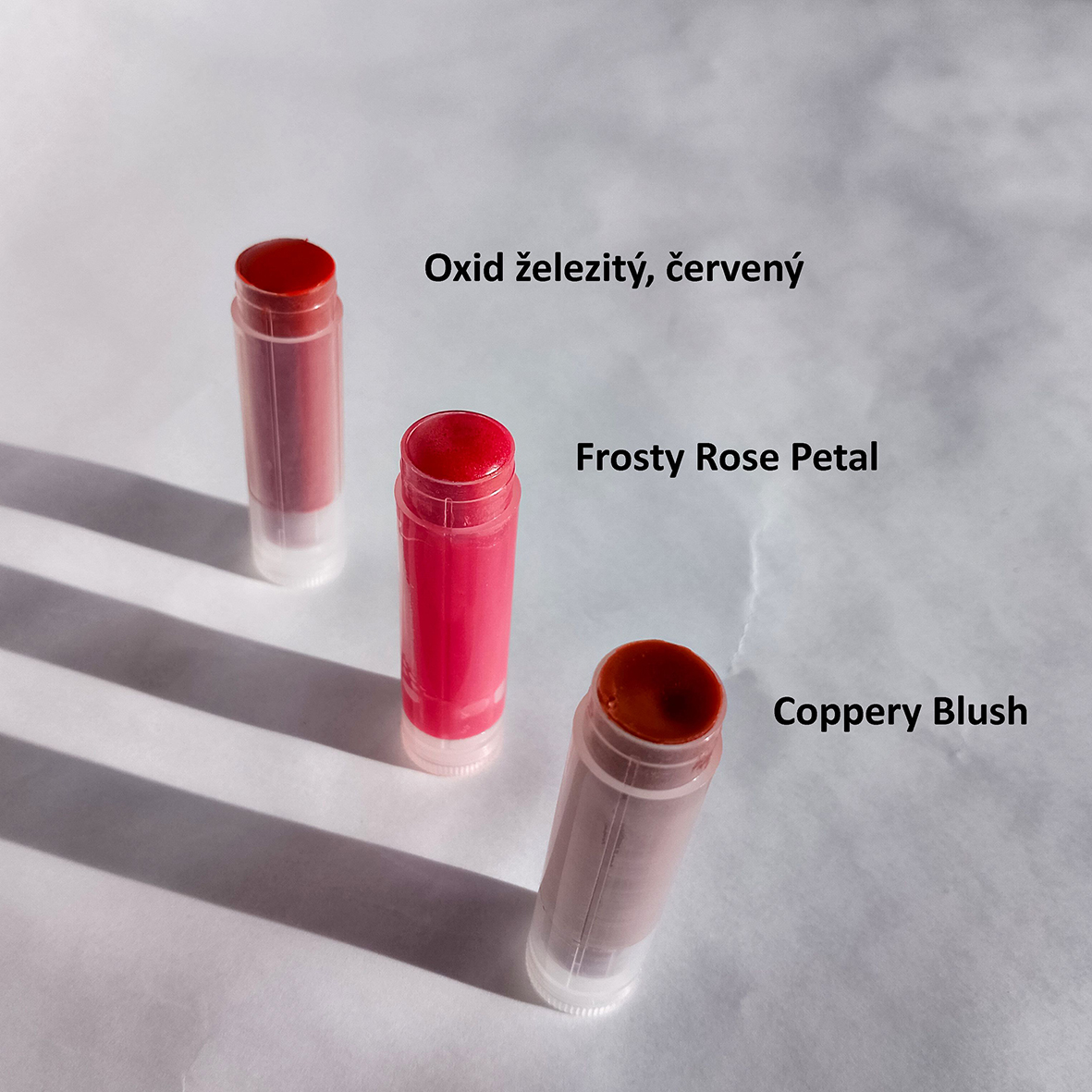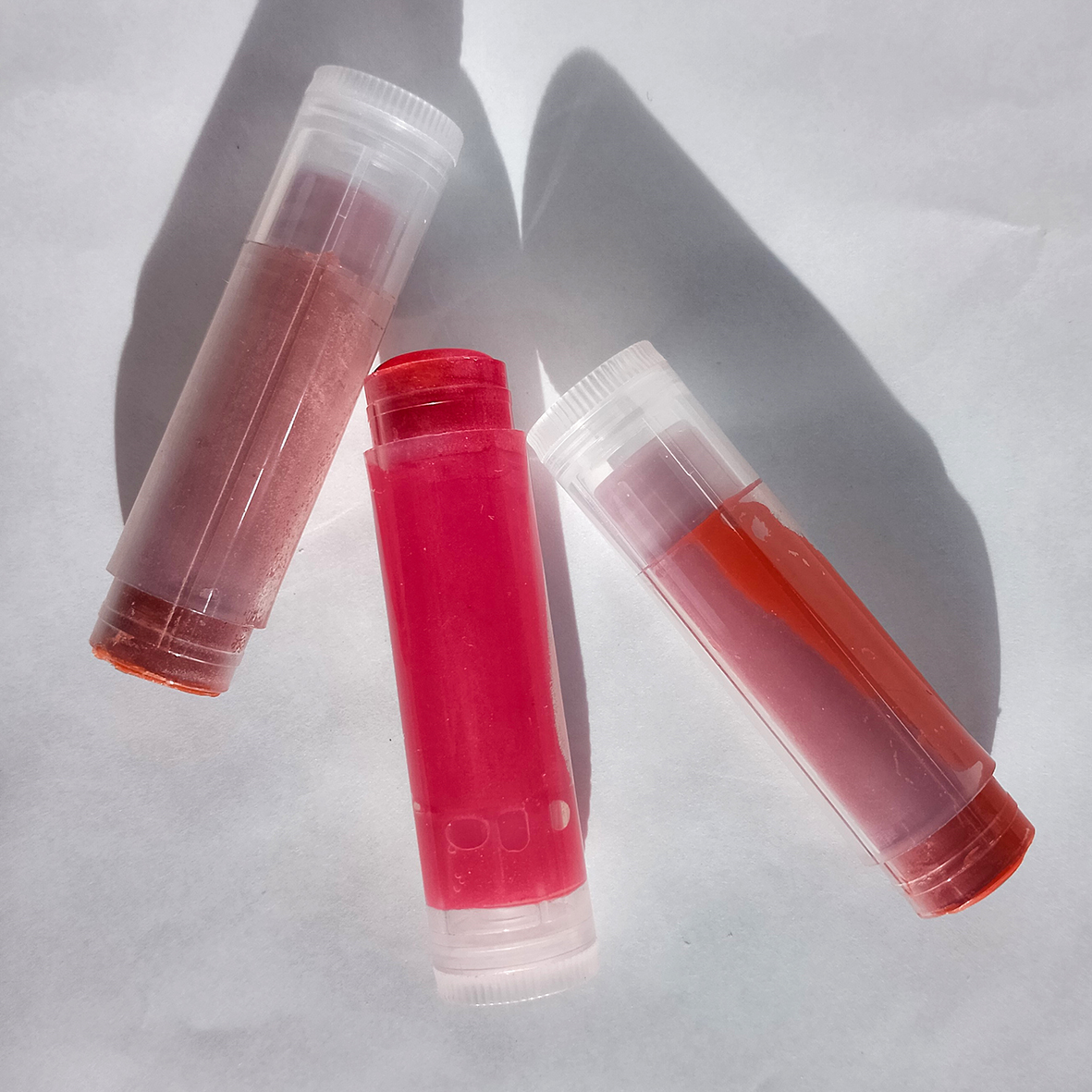Coloured lip balm
Combine a nourishing lip balm and your favorite colors and create it with us.
Tired of classic lip balms? Do you want to spice them up by adding coloured mica powders or other pigments? We offer you a variation on the classic lip balm with the addition of mica powders. The resulting colour effect is very natural, it is not a heavily pigmented product like lipsticks, and at the same time, anyone can make a colourful lip balm.
COLOUR LIP BALM - RAW MATERIALS
To make coloured lip balm you need a basic mixture of waxes, butters and oils. Sunflower lecithin is added to soften the balm. Mica powders have been chosen as the colour pigment, but you can also reach for red iron oxide.
INGREDIENCE phase %
A Bee wax, white 19,95
A Cocoa butter, unrefined 33,75
A Jojoba oil 42,55
A Sunflower lecithin 1,75
A Micapowder/iron oxide 2,00
lip balm packaging, transparent ---

COLOURED LIP BALM - PROCEDURE
1. disinfect all utensils, packaging and containers before use, e.g. by spraying with ethanol.
2. weigh all the ingredients into a heat-resistant container.
3. place the container on a water bath and heat until the waxes are melted and all the ingredients are thoroughly mixed.
4. pour the still liquid mixture into the prepared lip balm containers. Leave to set (ideally for 24 hours).
5.the product is ready to use.
COLOUR LIP BALM - TIPS AND TRICKS
Below you will find a few hints and tips to make making a coloured lip balm easier or more interesting. Be inspired by our tips and make a balm exactly to your liking.
You can reach for any mica powder when making a coloured lip balm. You can also change the amount - if you want a less intensely coloured product, add a smaller amount and vice versa.
If you find the colored lip balm too soft or melts during hot days, you can increase the proportion of wax. Conversely, if you want a softer balm, add 1-2% jojoba oil at the expense of beeswax. If you want to make a vegan product, reach for almond wax, for example.
When pouring, you can use a rubber band to hold the balm tubes together or put them in a smaller jar so that they don't tip over when pouring. Don't pour the coloured balm all the way in - a small cavity may form in the centre of the balm as it cools. You can cover this later by pouring in a small amount of balm.
We do not use water or any water-based ingredients in the colour balm, so there is no need for a preservative. To prolong the life of oils and butters, add 0.5% tocopheryl acetate (vitamin E) before pouring into the tube. Do not use tocopherol as it has a lower tolerance to higher temperatures and may break down.
You can also add flavourings to lip balms (amount according to manufacturer's recommendations), also mix these ingredients into the product just before pouring into the tube so that they are not exposed to elevated temperatures for long periods of time. Do not use fragrance oils and only use essential oils that are explicitly stated to be safe for use on the lips (this information can be found in the IFRA standard listed for each essential oil).
Before washing the utensils and containers used to make them , try to wipe as much of the residue from the coloured balm as possible with a paper towel. Afterwards, wash the utensils in the dishwasher or by hand with a common dishwashing liquid.

COLORED LIP BALM - INGREDIENTS AND THEIR IMPORTANCE
Do you want to know the meaning of the individual ingredients in the recipe for coloured lip balm? Here's an overview of them, together with an explanation of their dosage in the recipe, possible substitutions and how to customise your product.
WHISPERING WAX
Beeswax is a great basic ingredient for lip balms. This wax provides the hardness to the resulting stick balm (which is why a larger amount is used than for a balm to be applied with the fingers). At the same time, beeswax forms a protective film on the skin which prevents the lips from drying out. We chose white refined wax as it is free of colour and scent, so the pigments used can stand out, or the flavouring in the balm if you choose to add it.
Beeswax can be replaced with a natural version. For a vegan version of a coloured lip balm, almond wax is suitable as it has a similar hardness to beeswax. Alternatively, you can choose a different wax for making cosmetics(don't use waxes intended only for candle making), andif each wax has a slightly different melting point and hardness, which may affect the strength of the bar balm and its application or hardness.
COCAUT BUTTER
Do you know why cocoa butter is popular in lip products? The secret is hidden in its melting temperature, which is close to the temperature of the skin. This makes the coloured balm melt slightly on contact with the lips, making it easier to apply.
Cocoa butter can be substituted with other harder butters, but this will result in a change in the strength and stiffness of the resulting balm.
JOJOBO OIL
Nourishing jojoba oil combines wonderfully with the other ingredients used in the recipe for the colourful lip balm. You'll love this oil for its light colour and neutral scent. It can be replaced with other vegetable oils or you can play around with its representationm - a larger proportion of oil will create a softer lip balm with a creamier texture.
SUNFLOWER LECITHIN
A nourishing ingredient that provides protection to the skin of the lips while making it easier to apply to the lips is sunflower lecithin. This ingredient is not a necessary part of the recipe, you can even leave it out, but it gives the products a softer texture and the lecithin helps to moisturise the lips and leave them soft. An alternative to this ingredient is soya lecithin.
PIGMENT
To obtain a colourful lip balm, pigment must be added. This can be, for example, mica powder or iron oxide. You don't have to use just one kind of pigment, feel free to combine several and mix the shade exactly to your liking.
In our case, we used three different pigments to make the lip balm, namely Frosty Rose Petal mica powder, Coppery Blush and Iron Oxide Red. After applying each of the prepared balms, the colour result is subtle, these are not heavily pigmented products like lipsticks. However, the iron oxide gave a slightly stronger colour than the mica powders after applying the balm, but it was still a weaker colour effect that was comparable to the lip glosses.
PACKAGING AND STORAGE
Lip balm stick tubes are suitable as packaging. Don't use the cups - the balm will be too hard to apply with your fingers, it's designed to make a stick balm. A normal lip balm tube holds approximately 5g of finished product. It is preferable to work with quantities of at least around 15g to make pouring and weighing easier. Alternatively, you can prepare a base of balm without pigment and then remove from this base as needed and re-dissolve it in a water bath along with the selected pigment.
Do not leave the finished coloured lip balm in direct sunlight. If the balm changes colour or smell, the oils and fats in it have probably oxidised. Discard such balm, it is no longer suitable for use, and the tube can be washed in the dishwasher.
WARNING
As mentioned, you can experiment with homemade recipes to achieve the desired properties. However, many factors such as humidity, temperature, quality of ingredients and storage can affect the final result.
Before using any raw material to make a cosmetic product, familiarize yourself with its properties, recommended dosage, storage conditions or safe handling. Any raw material may have the potential to cause an allergic reaction in sensitive individuals, so before using a product, we recommend that you find out if you suffer from an allergy to any of the raw materials or the overall product, e.g. by a skin test.
If you have very sensitive or very acne-prone skin, or other skin and health problems, we recommend that you consult a medical professionalbefore applying a new product to your skin, whether it is a homemade cosmetic product, a pure raw material or a commercially available product.
COLOUR LIP BALM - CONCLUSION
Colored lips are a perfect match for the upcoming summer. Moisturised and luscious, full of colour, they are a must have. Treat yourself to a pleasant feeling on your lips with a colourful lip balm made from natural ingredients.
If you have any questions or insights to add to our process, be sure to email us at marketing@handymade.sk
Thank you to the great Ivana Jačalová for this procedure for creating a colourful lip balm.
Until we see you again for the next blog procedure, stay creative.
Until the saponification, my friends.


